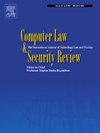Authorship in Human-AI collaborative creation: A creative control theory perspective
IF 3.2
3区 社会学
Q1 LAW
引用次数: 0
Abstract
The emergence of human-AI collaborative creation (HAIC) models has provided a good opportunity to uncover the principles of authorship identification. To clarify whether humans exert control over AI-generated content (AIGC) and whether such control is sufficient to confer authorship, we propose the theory of creative control from a law and aesthetics perspective. According to this theory, a human can claim authorship when they are guided by artistic imagery thinking and manifest individual creativity throughout the entire creation process from conception to execution. In the HAIC model, the unpredictable nature of the AI black box does not impede the recognition of users’ control, as users possess the capability for artistic imagery thinking to direct the entire creation process. If their contribution meets the originality standard, they qualify as the author of the AIGC. Current prevailing views that evaluate AIGC’s originality on the basis of either the final form of expression or the users’ prompts in the initial stage overlook the dynamic nature of the creative process.
人-人工智能协同创作的作者身份:一个创造性控制理论的视角
人类-人工智能协同创作(HAIC)模型的出现为揭示作者身份识别原则提供了一个很好的机会。为了澄清人类是否对人工智能生成的内容(AIGC)施加控制,以及这种控制是否足以授予作者,我们从法律和美学的角度提出了创造性控制理论。根据这一理论,当一个人在艺术意象思维的指导下,从构思到执行的整个创作过程中表现出个人的创造力时,他就可以声称自己是作者。在HAIC模型中,人工智能黑匣子的不可预测性并不妨碍对用户控制的识别,因为用户拥有艺术意象思维的能力来指导整个创作过程。如果他们的贡献符合原创性标准,他们就有资格成为AIGC的作者。目前流行的评价AIGC原创性的观点,要么是基于最终的表达形式,要么是基于用户在初始阶段的提示,忽视了创作过程的动态性。
本文章由计算机程序翻译,如有差异,请以英文原文为准。
求助全文
约1分钟内获得全文
求助全文
来源期刊
CiteScore
5.60
自引率
10.30%
发文量
81
审稿时长
67 days
期刊介绍:
CLSR publishes refereed academic and practitioner papers on topics such as Web 2.0, IT security, Identity management, ID cards, RFID, interference with privacy, Internet law, telecoms regulation, online broadcasting, intellectual property, software law, e-commerce, outsourcing, data protection, EU policy, freedom of information, computer security and many other topics. In addition it provides a regular update on European Union developments, national news from more than 20 jurisdictions in both Europe and the Pacific Rim. It is looking for papers within the subject area that display good quality legal analysis and new lines of legal thought or policy development that go beyond mere description of the subject area, however accurate that may be.

 求助内容:
求助内容: 应助结果提醒方式:
应助结果提醒方式:


